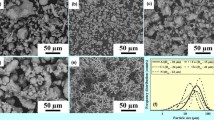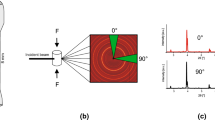Abstract
In the present work, a multi-principle element alloy (MPEA) with the five base elements Al, Cr, Fe, Ni and Ti in equimolar ratio plus additional elements was produced by powder metallurgy (MPEA5). Thereby, the influence of gentle compositional variations on the resulting material properties was investigated. The chosen MPEA compositions are closely related to conventional alloys (for comparison purposes). The goal is to supplement outstanding properties of existing alloys with MPEA-typical properties. For this purpose, the Al, Cr and Ti contents of the produced MPEA were separately reduced to a level as low as 10 mol%. Thereby, the remaining four base elements stay in equimolar proportion to each other. The starting materials were various prealloyed powders and elemental powders. The MPEAs were produced by combining and mechanical alloying of these powders and then were sintered by hot isostatic pressing. From thermodynamic calculation of stable phases it was predicted that the microstructure of MPEA5 consists of BCC- and Heusler-phases. Altering the chemical composition of MPEA5 by lowering the amount of Cr or Ti only resulted in minor changes of distributed phases. Calculation showed the stabilization of the C14_Laves phase (\(\hbox {Fe}_{2}\hbox {Ti}\)) with decreasing amount of Al. Microstructure analysis of the MPEAs via scanning electron microscopy, energy dispersive X-ray spectroscopy and X-ray diffraction confirmed the predicted phases. Properties analysis of the MPEAs was conducted via measurement of density and hardness tests. MPEA5 showed a measured density of \(6.33 \pm 0.32\) g/cm\(^3\) which coincides well to the predicted density via CALPHAD. MPEA5 reached a remarkable hardness of 839 HV10, which is at least 40% higher than the hardness of the established alloys L718 and W722, even if these were precipitation hardened. The reasons for the high hardness were the observed fine dispersion of the phases and the strong solid solution strengthening in MPEA5 and its modifications. Furthermore, it has been verified that a decrease of the Al amount in MPEA5 led to the formation of the hard C14_Laves-phase and an increase in hardness of the composition up to 912 HV10.









Similar content being viewed by others
References
Miracle, D.B., Senkov, O.N.: A critical review of high entropy alloys and related concepts. Acta Mater. 122, 448–511 (2017)
Yusenko, K.V., Riva, S., Crichton, W.A., Spektor, K., Bykova, E., Pakhomova, A., Tudball, A., Kupenko, I., Rohrbach, A., Klemme, S., Mazzali, F., Margadonna, S., Lavery, N.P., Brown, S.G.: High-pressure high-temperature tailoring of high entropy alloys for extreme environments. J. Alloys Compd. 738, 491–500 (2018)
Murty, B.S., Yeh, J.-W., Ranganathan, S.: High-Entropy Alloys. Amsterdam: Elsevier Reference Monographs, 1. aufl. ed. (2014)
Special Materials Corporation, “Inconel alloy 718: datasheet SMC-045” (2007)
von Kobylinski, J., Lawitzki, R., Hofmann, M., Krempaszky, C., Werner, E.: Micromechanical behaviour of Ni-based superalloys close to the yield point: a comparative study between neutron diffraction on different polycrystalline microstructures and crystal plasticity finite element modelling. Contin. Mech. Thermodyn. 31(3), 691–702 (2019)
Reed, R.C.: The Superalloys: Fundamentals and Applications. Cambridge University Press, Cambridge (2006)
Mignanelli, P.M., Jones, N.G., Pickering, E.J., Messé, O., Rae, C., Hardy, M.C., Stone, H.J.: Gamma-gamma prime-gamma double prime dual-superlattice superalloys. Scr. Materi. 136, 136–140 (2017)
Böhler Edelstahl GMBH & Co KG, “Böhler W722 VMR: datasheet” (2009)
Sedlak, J., Rican, D., Piska, M., Rozkosny, L.: Study of materials produced by powder metallurgy using classical and modern additive laser technology. Proc. Eng. 100, 1232–1241 (2015)
Nong, Z.-S., Lei, Y.-N., Zhu, J.-C.: Wear and oxidation resistances of AlCrFeNiTi-based high entropy alloys. Intermetallics 101, 144–151 (2018)
Chen, S.-K., Lee, P.-H., Lin, C.-H.: AlCoCrFeNiTi and its equal-molar five-component alloys in a metal mixological enthalpy-entropy plane. Q. Phys. Rev. 3(1), 1–28 (2017)
Liu, S., Gao, M.C., Liaw, P.K., Zhang, Y.: Microstructures and mechanical properties of Al CrFeNiTi0.25 alloys. J. Alloys Compd. 619, 610–615 (2015)
Soni, P.R.: Mechanical Alloying: Fundamentals and Applications. Cambridge International Science Publishing, Cambridge (2001)
Suryanarayana, C.: Mechanical alloying and milling, vol. 22 a of Materials engineering. New York: Dekker (2004)
Gilman, P.S., Benjamin, J.S.: Mechanical alloying. Annu. Rev. Mater. Sci. 13(1), 279–300 (1983)
Suryanarayana, C.: Mechanical alloying and milling. Progr. Mater. Sci. 46(1–2), 1–184 (2001)
Chen, Y.-L., Hu, Y.-H., Hsieh, C.-A., Yeh, J.-W., Chen, S.-K.: Competition between elements during mechanical alloying in an octonary multi-principal-element alloy system. J. Alloys Compd. 481(1–2), 768–775 (2009)
Liu, C.T., Stringer, J., Mundy, J.N., Horton, L.L., Angelini, P.: Ordered intermetallic alloys: an assessment. Intermetallics 5(8), 579–596 (1997)
Jung, J., Ghosh, G., Olson, G.B.: A comparative study of precipitation behavior of Heusler phase (Ni2TiAl) from B2-TiNi in Ni-Ti-Al and Ni-Ti-Al-X (X=Hf, Pd, Pt, Zr) alloys. Acta Mater. 51(20), 6341–6357 (2003)
Kučerová, L., Zetková, I., Jandová, A., Bystrianský, M.: Microstructural characterisation and in-situ straining of additive-manufactured X3NiCoMoTi 18-9-5 maraging steel. Mater. Sci. Eng. A 750, 70–80 (2019)
Yeh, J.-W., Chen, S.-K., Lin, S.-J., Gan, J.-Y., Chin, T.-S., Shun, T.-T., Tsau, C.-H., Chang, S.-Y.: Nanostructured high-entropy alloys with multiple principal elements: novel alloy design concepts and outcomes. Adv. Eng. Mater. 6(5), 299–303 (2004)
Werner, E., Wesenjak, R., Fillafer, A., Meier, F., Krempaszky, C.: Microstructure-based modelling of multiphase materials and complex structures. Contin. Mech. Thermodyn. 28(5), 1325–1346 (2016)
Marker, M.C.J., Duarte, L.I., Leinenbach, C., Richter, K.W.: Characterization of the Fe-rich corner of Al–Fe–Si–Ti. Intermetallics 39, 38–49 (2013)
dell’Isola, F., Seppecher, P., Spagnuolo, M., Barchiesi, E., Hild, F., Lekszycki, T., Giorgio, I., Placidi, L., Andreaus, U., Cuomo, M., Eugster, S.R., Pfaff, A., Hoschke, K., Langkemper, R., Turco, E., Sarikaya, R., Misra, A., de Angelo, M., D’Annibale, F., Bouterf, A., Pinelli, X., Misra, A., Desmorat, B., Pawlikowski, M., Dupuy, C., Scerrato, D., Peyre, P., Laudato, M., Manzari, L., Göransson, P., Hesch, C., Hesch, S., Franciosi, P., Dirrenberger, J., Maurin, F., Vangelatos, Z., Grigoropoulos, C., Melissinaki, V., Farsari, M., Muller, W., Abali, B.E., Liebold, C., Ganzosch, G., Harrison, P., Drobnicki, R., Igumnov, L., Alzahrani, F., Hayat, T.: Advances in pantographic structures: design, manufacturing, models, experiments and image analyses. Contin. Mech. Thermodyn. 31(4), 1231–1282 (2019)
Acknowledgements
J.v.K. gratefully acknowledges funding from the Deutsche Forschungsgemeinschaft (DFG, German Research Foundation) within Project 280883331.
Author information
Authors and Affiliations
Corresponding author
Additional information
Communicated by Andreas Öchsner.
Publisher's Note
Springer Nature remains neutral with regard to jurisdictional claims in published maps and institutional affiliations.
Rights and permissions
About this article
Cite this article
Reiberg, M., von Kobylinski, J. & Werner, E. Characterization of powder metallurgically produced AlCrFeNiTi multi-principle element alloys. Continuum Mech. Thermodyn. 32, 1147–1158 (2020). https://doi.org/10.1007/s00161-019-00820-z
Received:
Accepted:
Published:
Issue Date:
DOI: https://doi.org/10.1007/s00161-019-00820-z




